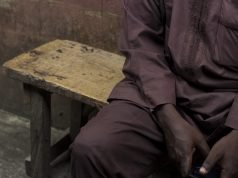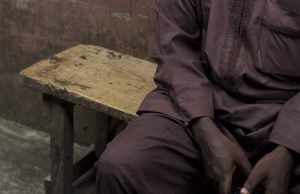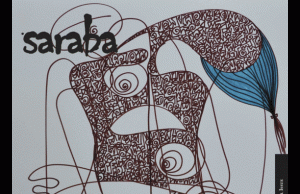
By Princess Ikatekit—
At a school social event, she waited for someone to ask her to dance, and wondered if she was too fat, too tall, too intimidating.
My mother had my sosh outfit made for me. I insisted, because the year before my sister had had her dress designed by Arapapa Fashion House, and she had emerged in all her photographs like an African queen. The black and white gown showed off her shoulders, emphasized her tiny midriff, and swept the ground when she walked. There might have even been a head-wrap—a regal crown to set it all off—but my jealousy may have supplied this last detail.
In any case, if my sister had had a dress designed for her, it was only fair that I should enjoy a similar privilege when my social came around. I decided not to dwell on the fact—and it is a testament to my mother’s kindness that she did not point out this out too—that it would have been darn near impossible to find a store-ready dress in my size that also fulfilled my other exacting requirements: it had to be modest, classy, and refined; it had to disguise and complement my substantial curves.
In the weeks leading up to our social, the girls in my hostel pranced up and down our hostel corridor in their high-heeled shoes, practicing their “catwalk.” And after the rest of the school had gone to bed, the more enthusiastic ones took even longer walks: down the gravel-filled pathways to the HSc classrooms, and then up the road, past the labs, the library, and the convent, and back to our hostels. They were cheerful about this. This was what it meant to be a seventeen or eighteen-year old girl on the brink of womanhood. The high-heeled shoe, the kakondo, was itself a rite of passage.
I did not attempt to break in my own shoes until a few days before the social. The heels were low: 1.5 inches, or 2 at the most, and I felt foolish toddling down the hostel corridor or pausing for too long at the full-length mirror that the twenty or so girls in my hostel all shared. I did not want to be seen to be trying so hard, for a mere boy(s). Still, the morning of our social, I allowed one friend to shape my eyebrows, and asked another to help apply make-up to my face. I took a container of hair-gel, which I had brought from home especially for that purpose, and rubbed the gel into my hair, teasing out curls that implied that I had made an effort with my hair, but not too much, like the girls—at other girls-only schools—who added extensions or wore strange wigs that looked completely out of place.
We, Form Sixes, made our way down from the hostels as a group when the boys’ buses arrived to pick us up. Having done it ourselves a few years before, we knew that the O’Levels would be staring expectantly from their dorm room windows. They would be passing judgment on our dresses, accessories, and shoes. They would be merciless in their critique:
Look at that one’s silk dress – it looks like a nightie!
Oh my God, the Head Girl has VPL (a visible panty-line)!
We found relative safety in numbers. Not only could we hide behind more confident friends, we could also feign nonchalance by engaging in lively conversations that seemed to dismiss the overbearing stares. And what were the stares of mere O’Level girls? If we could not withstand their criticism, how would we fare in front of the boys whose opinions mattered so much more?
—
My outfit consisted of a purple toe-length skirt that hugged my hips before flaring slightly at the knees, and a matching blouse done up with lace, sequin flower patterns, and a fitted bodice. The blouse left the tops of my shoulders bare, which drew attention to the glittering silver necklace that I wore with matching earrings. My shoes—low-heeled evening sandals—were silver. I may have even worn a silver watch or a bracelet that matched my necklace and earrings. I was confident that I presented a dignified and elegant front, so I walked with my head held high as we said hello to the boys who met us as we got off the bus, and walked with them through the school grounds to the dance hall.
As we walked, we were treated to the loud comments of the O’Levels. These boys, unlike girls, simply stopped what they were doing to stare at us unashamedly. They called out their appreciation as we made our way across their school, from their classrooms, and even from their sports field. And so although the calls were occasionally specific, for one particularly beautiful girl, we exalted in them as a group, laughing and loosening up, suddenly even more eager to enter the dance hall and “socialize.”
But inside the dance hall, we encountered a new awkwardness. It was easy to see that boys had put up the decorations. Black, white, and gold balloons hung in the far corners of the spacious hall, a few streamers were strung almost whimsically along the walls, and there was one big banner suspended at the front: NAMILYANGO AND NAMAGUNGA SOCIAL ‘07. There was a makeshift stage, presumably for the MC; several large speakers, and a few chairs ranged along the walls, for people who had danced so hard that they needed to sit down, or girls and guys too shy to dance in the first place.
When we entered the hall, our large group split like the red sea. The boys who had escorted us swerved to the left to join their classmates who had been waiting in the hall, and us girls swerved to the right, almost intuitively. There was a need to regroup and whisper our first impressions to each other. But as the music began to play, and a few bold couples broke the ice, boys and girls began to mingle.
I stood apart, at first, watching keenly as boys came up to ask girls to dance with them. A few were nervous: you could see it in the way they asked, scratching behind one ear, focusing on a spot just above the girl’s head. A few others were suave, asking with confident smiles, pulling the girls they liked from their groups of friends, and beginning to dance with practiced ease. It was amusing to observe all the rituals, to see couples dancing in and out of sync, until it occurred to me that no one had asked me to dance. Our group of girls in the corner was thinning quickly, and soon it was only about ten of us standing against the wall.
The concluding part of this essay will be published next week.
Princess Ikatekit, born and raised in Uganda, is a writer and editor. She lives and works in New York City.
Photo: Tango in Black by Zabara Alexander































